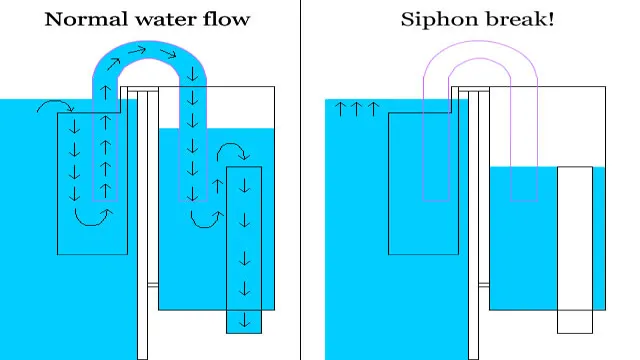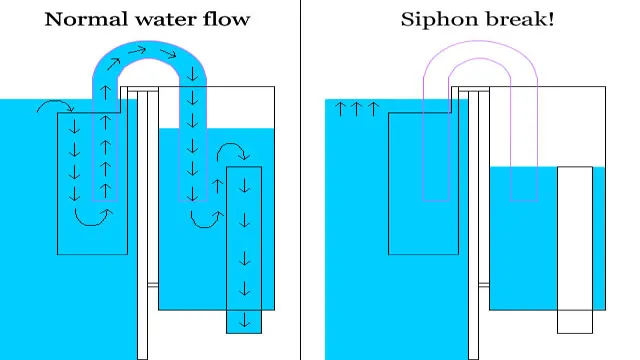Have you ever watched your fish swim peacefully in the aquarium and suddenly noticed a disturbance in the water current? Breaking the flow in an aquarium can be a common problem for hobbyists. It occurs when there is a sudden shift or disturbance in the water’s flow, which can impact the well-being of your aquatic friends. While it may seem like a minor issue, it can have a huge impact on your tank’s health and the fish’s ability to thrive.
In this blog, we will explore the causes of breaking the flow in an aquarium and how to prevent it. So, let’s dive in and learn how to keep the water flow steady for a happy, healthy aquarium!
Understanding the concept
Aquariums are a tranquil and calming way to bring a piece of the ocean into your home. However, sometimes the flow of the water can be disrupted, causing problems for your aquatic friends. One way to break the flow in an aquarium is to use a baffle.
This is a simple object, usually made of plastic or glass, that sits inside the aquarium and redirects the flow of the water. By placing a baffle in a strategic location in your aquarium, you can create a more peaceful environment for your fish or other aquatic life. Another way to break the flow in an aquarium is to add more plants.
The plants not only provide a natural beauty to your aquarium but also a natural way to break up the flow of the water. The plants will create a natural barrier that will help disperse the flow of the water, creating a more comfortable environment for your aquatic friends. With these simple tricks, you can break the flow in your aquarium and create a calming and serene environment for all to enjoy.
What is the flow in an aquarium?
Aquariums are a wonderful addition to any home. Whether you are a beginner or an experienced pet owner, understanding the concept of flow in an aquarium is crucial to keep your aquatic animals healthy and happy. The flow in an aquarium refers to the movement of water throughout the tank, and it is essential for creating a healthy environment for your fish, plants, and other inhabitants.
To achieve the perfect flow, you need to consider several factors, such as the type and size of the filter, the number and placement of water pumps, and the placement of decorations, rocks, and plants. Proper flow ensures that waste and debris are efficiently removed from the tank, particles are evenly distributed, and oxygen is supplied evenly throughout the water. By understanding the concept of flow, you can create a beautiful and healthy environment for your aquatic pets, promoting their overall well-being.

Why is it important to break the flow?
Breaking the flow is the act of interrupting a consistent pattern or routine. It can refer to anything from taking a break during a long workday to trying out a new hobby. But why is it important to break the flow? The concept is rooted in the idea that too much of a good thing can actually be detrimental.
When we focus on one task for too long, our brain can become exhausted and less efficient. However, taking a short break or switching to a different task can help our brain recharge and improve our overall productivity. Think of it like taking a breath during a long race- it allows us to reset and continue with renewed energy.
Incorporating intentional breaks into your routine can also improve creativity and reduce stress levels. So, don’t be afraid to mix things up and break the flow every once in a while!
Methods for breaking the flow
If you’re looking to create a more dynamic environment in your aquarium, then knowing how to break the flow is crucial. One method to achieve this is by using a wave maker. As its name implies, this device creates waves in your tank, providing your aquatic pets with an environment closer to their natural habitat. (See Also: How to Keep Aquarium Snails Alive: Tips and Tricks for a Healthy Tank Environment)
Another option is to rearrange your aquarium decorations. Simply moving the position of your rocks, plants, and even the substrate can create new currents within your tank. Consider adding a powerhead to provide additional water movement, especially in stagnant areas.
Lastly, you can also adjust your filtration system by lowering or increasing the water flow rate. By doing so, you can control the amount of water disturbance and prevent dead spots in your tank. Overall, breaking the flow in an aquarium is necessary to maintain a healthy environment for your aquatic friends.
Placement of decorations and plants
When it comes to decorating a space with plants and decor, the placement is key to breaking up the flow and creating visual interest. One method for achieving this is by using a variety of heights, such as placing tall plants next to shorter decor pieces or using hanging plants to add dimension to a room. Additionally, clustering objects together can create a focal point and draw the eye, whether it’s a collection of vases or a group of succulents.
Another fun idea is to mix and match different textures and colors, such as pairing a rustic wooden planter with a modern geometric vase. By playing around with different placement techniques, you can add personality and depth to any room in your home. Remember, the key is to keep an eye on the overall balance and scale of the space, and have fun experimenting with different arrangements.
Use of baffles and flow regulators
When it comes to flow regulation, baffles and flow regulators can be incredibly useful. Baffles are physical barriers that are placed within a pipeline to break up the flow of a liquid or gas. They help to slow down the flow and prevent it from becoming too fast, which can lead to turbulence and other issues.
Flow regulators, on the other hand, are devices that are designed to regulate the flow rate of a liquid or gas. They can be used to adjust the pressure or flow rate within a system, which can help to improve performance and efficiency. Whether you need to slow down a flow or regulate it more precisely, baffles and flow regulators can be valuable tools in the maintenance and control of pipeline systems.
With their help, you can ensure that your systems are running smoothly and efficiently, without the risk of turbulence, blockages, or other problems.
Adjusting flow rate of filter and pump
When it comes to adjusting the flow rate of your filter and pump, there are several methods you can use to break the flow. One effective method is to use a ball valve, which can be installed in the plumbing line to reduce the flow rate as needed. Another option is to use a flow restrictor, which can be placed in the plumbing line or directly in the filter to control the flow of water.
You can also adjust the speed of the pump itself, either by using a variable speed pump or by adjusting the RPMs manually. When adjusting the flow rate, it’s important to consider the size of your filter and pump, as well as the size of your pool or spa. By finding the right balance between flow rate and filtration, you can ensure that your water stays clean and clear while minimizing energy costs and improving the lifespan of your equipment.
So, why not try out these methods and achieve optimal flow rate for your filter and pump?
Maintaining a healthy aquarium
Maintaining a healthy aquarium requires attention to a lot of details, and one important factor to consider is the flow in the tank. Creating a steady, consistent water flow is essential for the health of aquatic creatures, but sometimes, you might need to break the flow to avoid harming them. Some species of fish might get swept away by the current, making it difficult for them to swim or feed. (See Also: How to Bond Acrylic for Aquarium: A Comprehensive Guide for a Strong and Safe Connection)
To break the flow, you can use an aquarium diverter or a spray bar to distribute the water evenly. Another option is to add plants or decorations that create natural barriers and break the water’s surface. Whatever method you choose, always monitor the flow and ensure it is not too strong or too weak.
Over time, you will learn the perfect flow for your aquarium and maintain a thriving aquatic ecosystem that your fish will love.
Regular water changes and cleaning
Maintaining a healthy aquarium is crucial for the survival of your fish and aquatic plants and requires regular water changes and cleaning. The process of cleaning your tank involves removing uneaten food, fish waste, and any other debris that may accumulate at the bottom of your aquarium. This can be done using a gravel vacuum or a siphon, which helps to suck out dirty water from the bottom of the tank.
While cleaning, you should also check on the temperature and pH levels of the water to ensure they are optimal for your fish. Regular water changes are also vital to keep the environment healthy. With a suitable aquarium gravel cleaner, you can remove 10-15% of the water and replace it with fresh water every week.
This refreshes the environment and keeps the fish healthy. By maintaining a clean and healthy aquarium, you can give your aquatic pets the perfect home they need to thrive.
Monitoring water parameters
Maintaining a healthy aquarium can be challenging, but monitoring water parameters is crucial. The water quality is essential for the health of your fish and aquatic plants. To maintain an optimal environment for your aquarium inhabitants, you need to monitor pH levels, temperature, ammonia, nitrite, and nitrate levels regularly.
pH levels can affect the health of your fish and plants, so it’s essential to keep the pH levels stable and within the range suitable for your specific aquatic inhabitants. Additionally, the water temperature can also impact their health, so you need to ensure that the temperature remains stable. High ammonia levels are toxic to your fish, and nitrite and nitrate levels can cause oxygen deprivation if not managed.
Testing water regularly with testing kits and changing water frequently can help you maintain healthy water quality. Remember, investing in proper maintenance and monitoring can save you time and money in the long run and keep your aquarium inhabitants healthy and happy.
Conclusion
Breaking the flow in an aquarium is not just about creating a peaceful environment for your aquatic friends. It’s about realizing that sometimes it’s important to go against the current, to break away from the expected and embrace the unexpected. So join your fish in their rebellion against the status quo and scatter some rocks or plants around to disrupt the flow.
Who knows, maybe in doing so, you’ll find yourself swimming upstream towards a happier and more fulfilling life.” (See Also: How to Change Aquarium Water with Fish in It: Step by Step Guide)
FAQs
Why is breaking the flow important in an aquarium?
Breaking the flow is important in an aquarium because it promotes better oxygenation and nutrient distribution throughout the tank, preventing stagnant areas.
How can I break the flow in my aquarium?
You can break the flow in your aquarium by adding plants, decorations, and porous rocks to create obstacles for the water flow. You can also use a wave maker or powerhead to create random water currents.
What are the benefits of breaking the flow in an aquarium?
The benefits of breaking the flow in an aquarium include creating a more natural environment for fish and plants, promoting better water quality, and reducing the chance of algae growth.
Can I use air stones to break the flow in my aquarium?
Yes, air stones can help break the flow in your aquarium by creating small bubbles that disrupt the water’s surface tension and create a gentle flow.
How often should I change the position of obstacles in my aquarium to break the flow?
It is recommended to change the position of obstacles in your aquarium every few weeks to prevent buildup of debris and encourage even flow throughout the tank.
Is it better to have one or multiple sources for breaking the flow in an aquarium?
It is better to have multiple sources for breaking the flow in an aquarium to create a more natural and randomized flow pattern.
Can breaking the flow in an aquarium affect the temperature or pH of the water?
Depending on the method used, breaking the flow in an aquarium may affect the temperature or pH of the water. It is important to monitor these parameters and adjust accordingly.







